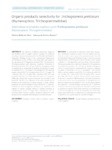Please use this identifier to cite or link to this item:
http://www.alice.cnptia.embrapa.br/alice/handle/doc/1066441| Title: | Organic products selectivity for Trichogramma pretiosum (Hymenoptera: Trichogrammatidae). |
| Authors: | SILVA, D. M. da  BUENO, A. de F.   |
| Affiliation: | DÉBORA MELLO DA SILVA, UEL; ADENEY DE FREITAS BUENO, CNPSO. |
| Date Issued: | 2015 |
| Citation: | Arquivos do Instituto Biológico, v. 82, p. 1-8, 2015. |
| Description: | ABSTRACT: The selectivity of different insecticides, fungicides and fertilizers used in organic soybean cropping was evaluated according to the protocols proposed by the Pesticides and Beneficial Organisms Working Group of the International Organization for Biological Control (IOBC) concerning adults and pupae of the egg parasitoid Trichogramma pretiosum Riley (Hymenoptera: Trichogrammatidae) under laboratory conditions. Treatments 1) baculovirus anticarsia 140 x 109 cpi; 2) Bacillus thuringiensis 16.8 g; 3) azadirachtin-A, azadirachtin-B, nimbina and salamina 9.6 ppm; 4) rotenoids 4% 4 L; 5) nitrogen 1.3%, phosphorus 3.0% and total organic carbon 8.0% 3 L; 6) sodium silicate 2% 4 L; 7) copper 7% + calcium 3.3% 1.8 L; 8) sulfur 20% + quicklime 10% 1.8 L were in general safe (class 1) to both adults and pupae of T. pretiosum. Differently, chlorpyrifos (control treatment) was harmful to this parasitoid. Therefore, the utilization of the tested natural derived products in the production of organic soybean is viable, without impairing the natural biological control allowed by T. pretiosum. Furthermore, both management techniques can indeed be used together in organic cropping aiming at reaching increasing or complementary control of target pests. Chlorpyrifos use, on the other hand, whenever possible, should be replaced by other products more compatible with biological control preservation. CONTEÚDO: A seletividade de diferentes inseticidas, fungicidas e fertilizantes usados no cultivo de soja orgânica foi avaliada de acordo com os protocolos propostos pela pesticide and Beneficial Organisms Working Group of the International Organization for Biological Control (IOBC) sobre pupas e adultos de Trichogramma pretiosum Riley (Hymenoptera: Trichogrammatidae) em condições de laboratório. Os tratamentos 1) baculovírus anticarsia 140 x 109 cpi; 2) Bacillus thuringiensis 16,8 g; 3) azadirachtin-A, azadirachtin-B, nimbina e salamina 9,6 ppm; 4) rotenoides 4% 4 L; 5) nitrogênio 1,3%, fósforo 3,0% e carbono orgânico total 8,0% 3 L; 6) silicato de sódio 2% 4 L; 7) cobre 7% + cálcio 3,3% 1,8 L; 8) enxofre 20% + cal virgem 10% 1,8 L foram, no geral, inócuos (classe 1) para pupas e adultos de T. pretiosum. Diferentemente, clorpirifós (tratamento controle) foi nocivo para esse parasitoide. A utilização dos produtos de origem natural avaliados é viável na sojicultura orgânica sem impactar o controle biológico promovido por T. pretiosum. Ambas as táticas de manejo podem ser utilizadas conjuntamente na agricultura orgânica objetivando aumentar ou complementar o controle da praga-alvo. O uso do clorpirifós, por outro lado, sempre que possível, deve ser substituído por outros produtos mais compatíveis com a preservação do controle biológico. |
| Thesagro: | Entomologia |
| ISSN: | 1808-1657 |
| DOI: | 10.1590/1808-1657000422013 |
| Type of Material: | Artigo de periódico |
| Access: | openAccess |
| Appears in Collections: | Artigo em periódico indexado (CNPSO)  |
Files in This Item:
| File | Description | Size | Format | |
|---|---|---|---|---|
| 18081657aib000422013.pdf | 290,75 kB | Adobe PDF |  View/Open |









